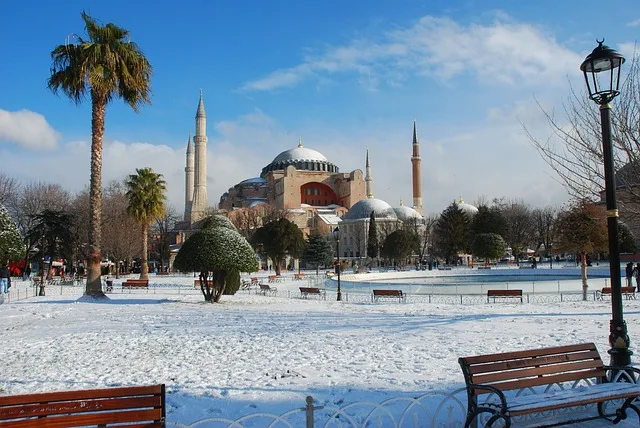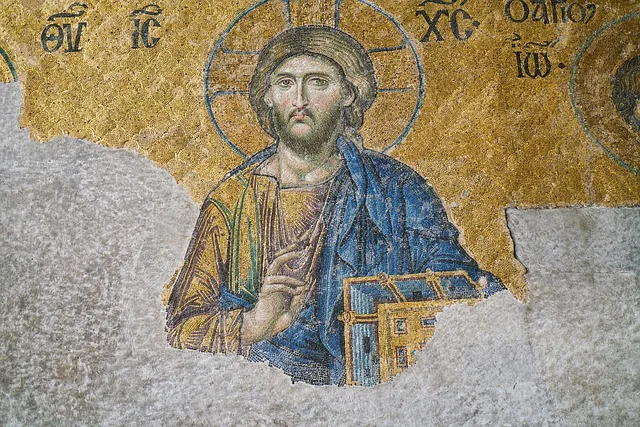The sheer scale of the Hagia Sophia is mind-boggling. With its massive dome soaring high above, it feels as if the heavens themselves are within reach. Have you ever gazed up at a starry sky and felt a sense of wonder? That’s the kind of awe you experience here. The way light filters through the intricate mosaics creates a dance of colors that captivates your senses. It’s as if the walls are alive, telling tales of Byzantine emperors and Ottoman sultans.
But what truly sets the Ayasofya apart is its architectural brilliance. It’s a masterclass in engineering, blending elements of both basilica and mosque design. The innovative use of arches and domes was revolutionary for its time, influencing countless structures around the world. Think of it as the original blueprint for modern architecture, inspiring everything from cathedrals to skyscrapers.
Hagia Sophia: A Timeless Testament to Architectural Ingenuity and Cultural Fusion
When you step inside, the sheer scale of the dome takes your breath away. It’s as if the heavens have opened up just for you. The way light filters through the massive windows creates a dance of shadows and illumination, making the interior feel alive. This architectural feat was groundbreaking for its time, showcasing the genius of Byzantine engineers who dared to push the boundaries of what was possible. Can you imagine the excitement of those first visitors, gazing up in awe at the intricate mosaics and soaring arches?
But Hagia Sophia isn’t just about its stunning design; it’s a symbol of cultural fusion. Picture this: a place where Eastern and Western traditions collide, where Christian iconography meets Islamic artistry. It’s like a beautiful marriage of two worlds, each contributing to the other’s richness. The calligraphy that adorns its walls speaks of a deep respect for both faiths, inviting everyone to appreciate the beauty of diversity.
From Basilica to Mosque: The Evolution of Hagia Sophia as an Architectural Marvel
But then, in 1453, everything changed. The Ottomans swept in, and Hagia Sophia transformed into a mosque. Can you imagine the shift? The vibrant Christian mosaics were covered, and minarets pierced the sky, adding a new layer to its already rich tapestry. It became a symbol of Islamic architecture, blending the old with the new. The call to prayer echoed through its vast halls, replacing the choral hymns that once filled the air.
As centuries rolled on, Hagia Sophia continued to evolve. In 1935, it opened as a museum, welcoming visitors from all corners of the globe. This shift was like peeling back layers of paint to reveal a masterpiece underneath. People marveled at its intricate designs, a fusion of Christian and Islamic elements, showcasing the beauty of cultural exchange.
Exploring the Architectural Wonders of Hagia Sophia: A Journey Through Time
As you wander through its vast halls, you can almost hear the whispers of the past. The soaring arches and grand columns create a sense of awe, making you feel small yet connected to something much larger than yourself. It’s like being in a giant, ornate treasure chest filled with the jewels of history. Each corner reveals stunning details, from the delicate calligraphy to the vibrant frescoes that tell tales of saints and emperors.
But what truly sets Hagia Sophia apart is its ability to adapt. It’s been a church, a mosque, and now a museum, reflecting the ever-changing tapestry of cultures and beliefs. Can you think of another place that has transformed so dramatically yet retained its essence? The interplay of light and shadow within its walls creates a magical atmosphere, inviting you to pause and reflect.

Visiting Hagia Sophia isn’t just about admiring its beauty; it’s about experiencing a living testament to human creativity and resilience. Each visit feels like a new chapter in a never-ending story, where every stone has a voice and every mosaic has a memory. So, are you ready to embark on this unforgettable journey through time?
Hagia Sophia: The Architectural Masterpiece That Defied the Ages

Constructed in 537 AD, Hagia Sophia was originally a cathedral, a place where the echoes of prayers and hymns filled the air. Fast forward a few centuries, and it transformed into a mosque, adapting to the changing tides of time. Isn’t it fascinating how it has seamlessly blended different cultures and religions? The intricate mosaics and stunning calligraphy tell tales of Byzantine and Ottoman influences, making it a true melting pot of artistry.
But what really sets Hagia Sophia apart is its sheer scale and innovative design. The massive dome, with its 40 windows, creates an ethereal light that dances across the marble floors, almost like a celestial spotlight. It’s as if the building itself is alive, breathing history and inviting you to explore its secrets. Have you ever wondered how something built so long ago can still inspire awe today? It’s a testament to human creativity and resilience, standing tall against the test of time.
Visiting Hagia Sophia is like stepping into a time machine, where every corner whispers stories of the past. Whether you’re an architecture buff or just someone looking for a slice of history, this masterpiece is sure to leave you spellbound. So, what are you waiting for? Dive into the wonder that is Hagia Sophia and let its magic sweep you off your feet!
The Secrets of Hagia Sophia: How Engineering and Art Converged in a Historic Landmark
Picture this: the dome is supported by a series of semi-domes and arches that distribute weight in a way that defies gravity. It’s like a perfectly balanced game of Jenga, where every piece is crucial to keeping the whole structure standing tall. The architects, Isidore of Miletus and Anthemius of Tralles, didn’t just build a church; they created a masterpiece that would inspire generations. They understood that light was an artist too. The way sunlight streams through the windows creates a magical atmosphere, illuminating the intricate mosaics that tell stories of faith and history.
Speaking of mosaics, have you ever noticed how they seem to come alive? Each tile is a tiny piece of a larger narrative, shimmering with gold and color, inviting you to explore deeper. It’s as if the walls are whispering secrets of the past, revealing the convergence of spirituality and artistry.
Hagia Sophia: A Symbol of Resilience and Architectural Brilliance Through the Centuries
When you step inside, the sheer scale of the dome takes your breath away. It’s like standing beneath the sky itself, with light pouring in through the massive windows, creating a celestial atmosphere. This architectural marvel was a groundbreaking feat for its time, showcasing the ingenuity of Byzantine engineers. They didn’t just build a church; they crafted a masterpiece that would inspire generations of architects and artists.
But Hagia Sophia’s journey hasn’t been a smooth one. It has transitioned from a cathedral to a mosque, and now a museum, reflecting the cultural shifts of the region. Each phase added layers to its identity, much like a well-loved book that reveals new chapters with every read. This adaptability is what makes Hagia Sophia a symbol of resilience. It has weathered earthquakes, political upheavals, and changing ideologies, yet it stands tall, inviting visitors from around the globe to marvel at its beauty.
As you explore its intricate mosaics and grand arches, you can’t help but feel a connection to the past. It’s as if the spirits of those who walked its halls centuries ago are still present, sharing their stories with anyone willing to listen. Hagia Sophia isn’t just a building; it’s a bridge between cultures, a reminder that beauty and strength can coexist, no matter the challenges faced.
The Dome of Dreams: Unraveling the Architectural Genius Behind Hagia Sophia
So, what’s the secret behind this stunning dome? Picture this: built in the 6th century, the Hagia Sophia was designed by two brilliant architects, Anthemius of Tralles and Isidore of Miletus. They didn’t just want to create a building; they aimed to craft a heavenly experience. The dome, with its 31 meters in diameter, is supported by a series of semi-domes and arches that distribute weight like a well-balanced seesaw. It’s a perfect example of how ancient architects used geometry to create something that feels both monumental and ethereal.
As you gaze up at the dome, you might notice the light streaming through the windows, creating a celestial glow that dances across the marble floors. This isn’t just for show; it symbolizes the divine light of heaven pouring into the earthly realm. It’s like the architects were trying to bridge the gap between the mortal and the divine, inviting visitors to feel a sense of transcendence.
Frequently Asked Questions
What are the key features of Ayasofya Hagia Sophia’s architecture?
The architecture of Ayasofya Hagia Sophia is renowned for its massive dome, innovative use of light, and harmonious proportions. Key features include the central dome supported by pendentives, extensive use of mosaics, and a blend of Byzantine and Islamic architectural elements. Its design allows for a vast interior space, creating an awe-inspiring atmosphere that has captivated visitors for centuries.
What are the cultural impacts of Ayasofya Hagia Sophia today?
The Ayasofya Hagia Sophia serves as a significant cultural symbol, reflecting the historical interplay between Christianity and Islam. Today, it influences art, architecture, and tourism, attracting visitors from around the world. Its status as a museum and mosque fosters dialogue about heritage, identity, and coexistence, impacting local communities and global perceptions of cultural diversity.
What is the historical significance of Ayasofya Hagia Sophia?
Ayasofya Hagia Sophia is a monumental structure that reflects the architectural and cultural achievements of the Byzantine Empire and later the Ottoman Empire. Originally built as a cathedral in the 6th century, it served as a center of Orthodox Christianity before being converted into a mosque in the 15th century. Its historical significance lies in its role as a symbol of religious transition, architectural innovation, and cultural fusion, influencing both Eastern and Western art and architecture.
How did Ayasofya Hagia Sophia influence architectural design?
The structure of Ayasofya Hagia Sophia has significantly influenced architectural design by introducing innovative features such as its massive dome, which inspired the development of domed structures in both religious and secular buildings. Its harmonious blend of Byzantine and Islamic architectural elements set a precedent for future designs, showcasing the potential for cultural synthesis in architecture. The use of light, space, and intricate mosaics in Hagia Sophia has also impacted aesthetic principles in architecture, making it a pivotal reference point for architects throughout history.
How has the function of Ayasofya Hagia Sophia changed over time?
The structure has transitioned from a cathedral to a mosque, and now serves as a museum and a mosque again. Originally built as a Christian basilica in the 6th century, it was converted into a mosque in the 15th century after the Ottoman conquest. In the 20th century, it became a museum, symbolizing a blend of cultures. Recently, it has reverted to functioning as a mosque, reflecting ongoing historical and cultural significance.

